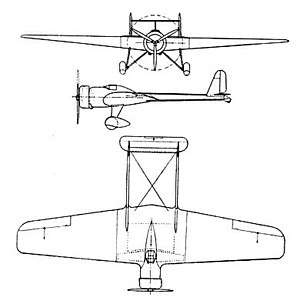Vance Viking
The Vance Viking, also called the Vance Flying Wing Express, and the Texas Sky Ranger, was a single seat cargo and racing aircraft.[2]
| Viking | |
|---|---|
 | |
| Vance Viking 3-view drawing from L'Aerophile February 1933 | |
| Role | Racing aircraft |
| National origin | United States of America |
| Manufacturer | Vance Aircraft Company |
| Designer | Claire K. Vance |
| First flight | July 1932[1] |
Design and development
Claire K. Vance founded the Vance Aircraft Corporation to build the "Flying Wing" design.[3] The aircraft was designed though a series of hand-carved wooden models before drawings were made, with the intention of it being a high speed, high altitude air-freighter with storage in thick wing lockers. Its short air racing history was interrupted by the 1932 death of its designer Claire Vance[4] who struck a fog-covered mountain at Rocky Ridge.[5]
The "Flying Wing" was a conventional long-range aircraft for the period with the exception of the two large booms aft of the cockpit supporting the twin tail surfaces and twin rudders, rather than a conventional fuselage. The tandem seat aircraft was converted to a single pilot aircraft that featured a radial engine and conventional landing gear (one tailwheel for each boom). Fourteen fuel tanks totaling 1,200 U.S. gallons (4,500 L; 1,000 imp gal) were interconnected inside the cantilevered mid-wing. The aircraft was of mixed construction, with an aluminum-covered welded steel tube fuselage. The wing used wooden wing spars with plywood covering. A forced air induction system was built into the wing roots with exhausts mounted near the trailing edges.[6]
Operational history
In 1932 the Viking dropped out of the Bendix Trophy race following fuel system issues.[7] In 1933 it was entered, but did not compete in the Bendix Trophy race.[8]
In 1934 Lt. Murray B. Dilley purchased the aircraft and production rights from Claire Vance's estate for $10,000 with the intention of racing the aircraft in the 1934 England-Australia MacRobertson Air Race.[9] Dilley only paid $2500 of the amount owned, and abandoned the aircraft in the desert near Palm Springs, California. During 1936 The Flying Wing was bought at auction in 1936 for $2500 by the Mason Aircraft Corporation. Clyde Pangborn planned on using the aircraft for a Dallas, Texas to Moscow Flight.[10] Later the aircraft was returned to tandem configuration, a radio compass was installed, it was re-painted red and white and christened "The Texas Sky Ranger". Roland W. Richards sponsored the aircraft as part of a publicity campaign for the Texas Centennial Exposition to fly to New York, Paris, visit London, Amsterdam, Madrid, and Brussels and then return on a non-stop Paris to Dallas flight with Pangborn and Mony Mason as pilots.[11] Mason backed out by not meeting a commitment, but the flight was planned to continue independently with Pangborn with newspaper sponsorship.[12]
Specifications (Vance Viking)
Data from Flight
General characteristics
- Crew: 1
- Wingspan: 60 ft (18 m)
- Fuel capacity: 1,200 U.S. gallons (4,500 L; 1,000 imp gal)
- Powerplant: 1 × Pratt & Whitney Wasp Radial, 660 hp (490 kW)
- Propellers: 2-bladed Hamilton Standard
Performance
- Maximum speed: 170 kn (200 mph, 320 km/h)
- Cruise speed: 140 kn (160 mph, 260 km/h)
- Range: 6,500 nmi (7,500 mi, 12,100 km)
- Service ceiling: 35,000 ft (11,000 m)
Avionics
- Automatic Pilot
References
- Air pictorial: journal of the Air League, Volume 36. p. 64.
- Flying Magazine: 44. May 1948. Missing or empty
|title=(help) - "Claire Vance". Retrieved 6 February 2018.
- William T. Larkins, Ronald T. Reuther. San Francisco Bay Area Aviation. p. 41.
- "Tailless aircraft in the USA". Retrieved January 30, 2011.
- "tailless aircraft in the USA". Retrieved January 30, 2011.
- Don Vorderman. The great air races. p. 187.
- "1933 National Air Races". Retrieved 30 December 2011.
- "The England-Australia Race". Flight. 23 August 1934.
- "Vance Flying Wing Plane Brings $2500". Berkley Daily Gazette. 2 June 1936.
- Jay Wells (17 July 1936). "Pangborn Plans Paris to Dallas non-stop flight". Berkley Daily Gazette.
- "Drop Sponsorship of Atlantic Flight". Berkley Daily Gazette. 20 July 1936.